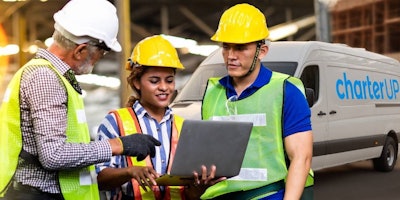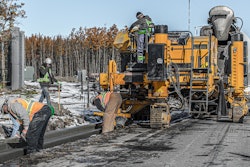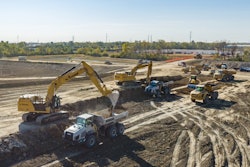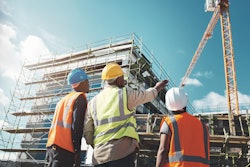
The cost of construction projects has escalated to levels unseen in decades, and many of the culprits are unavoidable economic forces like supply chain issues and inflation. But there’s one unexpected expense nibbling away at project margins that is easier to control: crew transportation.
While the cost of transporting equipment and materials are meticulously accounted for in project estimates, the expense of transporting crew members is an inefficiency that can subtly but steadily cause a budget to crumble.
Direct Costs: Beyond Meters and Miles
When big projects kick off in the heart of our cities, parking costs start as small bites out of contractors' pockets, but soon swell into a giant threat to the project's budget. In the crowded streets of downtown, parking charges can skyrocket to more than $50 a day, snatching away $7,000 from each worker's yearly earnings — a heavy load that's increasingly falling on employers' backs. Construction companies are in a tight spot, trying to ease this pain by snagging parking permits right on site or hashing out parking deals with nearby shops, only to see their budgets and to-do lists grow.
But parking woes are just the tip of the iceberg. More costs come with each journey to and from the site, as vehicle wear-and-tear pile up and gas prices climb, pumping up the project's costs even more.
The additional administrative overhead involved in managing parking logistics and reimbursements further bloats operational costs. This tangle of logistical headaches might look small at first, but it quickly adds up to big expenses, shaking the project's financial foundation and making it harder and more expensive to finish.>
Productivity Costs: Time Lost is Money Lost
The city's maze of traffic jams, sudden detours and the endless hunt for parking close to jobsites eats up crucial work time, throwing schedules off track and turning small delays into big problems. To keep their teams working and on schedule, construction managers sometimes end up paying for parking fines — a Band-Aid fix for a complex issue that really needs a strategic solution.
All these disruptions are more than just annoying —they seriously cut into work efficiency, risking longer project delays, rising costs and shrinking profits.
Indirect Costs: Coordination and Safety
The rush to find parking and get to the site on time doesn't just stress out workers; it also makes their daily commute riskier, adding danger to an already challenging day. Plus, the mess caused by parking troubles and people getting to work at different times breaks the flow of work, leading to less getting done.
Adding another layer of complexity to this scenario is the consideration of worker fatigue after long, labor-intensive shifts. After clocking in 10-plus hours of strenuous work, the last thing workers need is the responsibility of navigating their way home, especially during the precarious low-light conditions of early mornings or late evenings.
These problems, while not as obvious as outright costs, have a big impact, delaying projects, bumping up expenses and cutting into profits. The risk isn't just about possible accidents, it's about creating a stressful and distracting work environment that could lower the quality and safety of the construction work.
The Case for Shuttle Solutions
In response to these challenges, jobsite shuttle services emerge as a smart solution. By ensuring that crews arrive together, these shuttles enhance operational efficiency, safety and team coordination. In cities like New York, Philadelphia or Phoenix, where parking and traffic are particularly problematic, shuttle services can save valuable time and money, directly addressing the direct and indirect costs highlighted above.
Transforming Inefficiencies Into Opportunities
Adopting shuttle services is not merely a logistical decision; it's a strategic move toward more efficient and cost-effective project management. Shuttles can significantly reduce the number of vehicles needed for crew transportation, thereby decreasing fuel consumption, emissions and the overall carbon footprint of construction activities.
Moreover, the predictability and reliability of shuttle services can improve project planning and execution. By eliminating the variables associated with individual transportation, project managers can better forecast timelines, allocate resources more efficiently and enhance overall project delivery.
Here’s how construction firms can practically implement such services:
- Partner with Transportation Providers: Identify and collaborate with local shuttle service providers experienced in catering to construction site needs, ensuring they can accommodate fluctuating schedules and varied site locations.
- Cost-Benefit Analysis: Conduct a thorough analysis comparing the cost of implementing shuttle services against the savings on parking, fuel and reduced time delays. Projects with shuttles in urban areas have reported significant reductions in indirect costs, such as minimized downtime and lower environmental impact fees.
- Coordinate with Urban Planning Efforts: For urban projects, align shuttle routes and schedules with city transportation plans to enhance efficiency and compliance. This strategic alignment not only facilitates smoother operations but also contributes to broader urban sustainability goals.
- Regulatory and Safety Considerations: Ensure shuttle services comply with local transportation regulations, focusing on vehicle safety standards and driver qualifications. Implementing a shuttle service with this in mind can lead to improved worker satisfaction and reduced liability for construction firms.
- Customize to Project Needs: Tailor shuttle services to the specific requirements of each project, considering factors like site location, crew size and project duration. Flexibility in shuttle scheduling can accommodate varying work phases and shifts, ensuring that transportation aligns seamlessly with project timelines.
Streamlining Construction Logistics
The construction industry is at a crossroads, facing the dual challenges of urban congestion and the need for efficient operations. Shuttle services stand out as a strategic tool to overcome the challenges and complexities of modern construction projects, providing a direct route to enhanced project efficiency.
Urban sites: In urban environments, where traffic jams and the hunt for parking can derail project schedules, shuttle services offer a lifeline. Tailored route planning and the flexibility to adapt to city dynamics ensure that construction teams can bypass congestion, arriving on-site ready for a productive day. This approach not only eases parking strains but also plays a part in lessening urban congestion, making cities more livable for all.
Remote sites: The expansion into suburban and rural areas brings its own set of logistical hurdles, primarily the lack of convenient public transport options. Here, shuttles become the bridge connecting workers to sites that might otherwise be inaccessible. By carefully planning routes that cover these longer distances effectively, shuttle services ensure every team member has reliable access to work, keeping projects on track and within budget.
Improved safety: A standout advantage of shuttle services is their role in promoting safety and managing worker fatigue, especially after long hours of physical labor. Shuttle drivers adhere to the strict regulations set by the Federal Motor Carrier Safety Regulations (FMCSR), working within controlled shifts to avoid tiredness. This ensures a safer, more reliable ride home for construction workers after a demanding day. This facet of shuttle services not only uplifts the safety standards but also underscores the commitment to worker well-being and project efficiency.
Embracing Shuttle Services as a Forward-Thinking Solution
The construction industry can redefine what efficient and responsible builds look like in the 21st century. This strategic shift not only addresses the immediate challenges of project management but also aligns with broader industry trends.
As the industry faces increasing pressures, innovative transportation solutions like jobsite shuttles offer a practical approach to overcoming traditional inefficiencies, marking a new standard for operational excellence in construction.
In an era where every dollar and minute counts, reevaluating crew transportation logistics through the lens of shuttle services is not just an operational decision — it's a strategic investment in the future of construction project management.



















